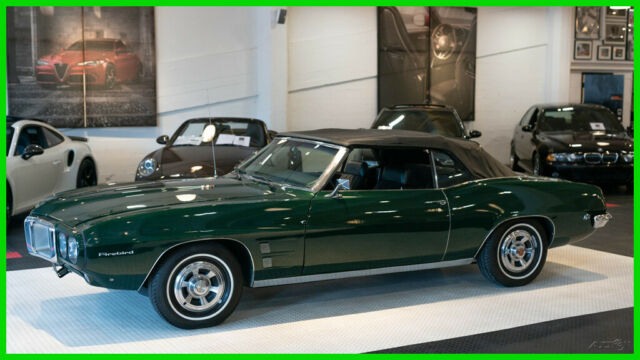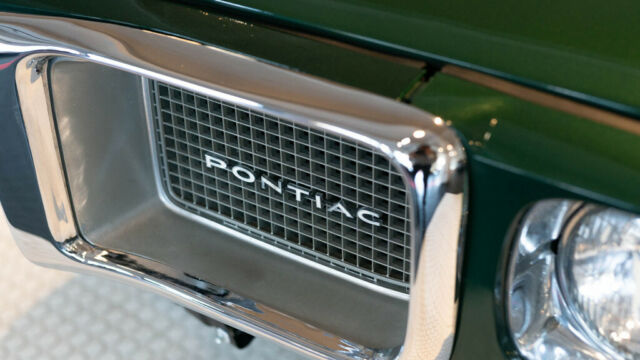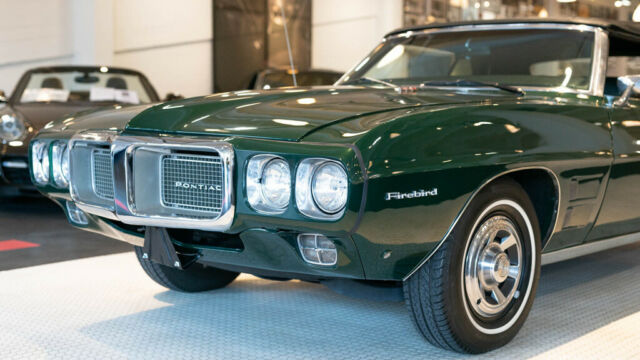Description
Introducing a 1969 Pontiac Firebird convertible with rebuilt 350 c.i engine, matching numbers, in Green with Black interior.This particular vehicle comes with Power Steering, New suspension and a rebuilt transmission with no leaks.All seals have recently been replaced.The carburetor has been rebuilt.The car just received a new interior and new Power Top, new tires and wheels.Other recent improvements include :- New ignition contact set-New Spark Plugs-New distributor cap-New distributor rotor-New V- belts-New Brake Master cylinder-New oil Pan-New spark plug wire set-New Oil Seal-New Water pump-New blower motor-New Battery.Some history of the 1969 Pontiac Firebird.The first generation Firebird had characteristic Coke bottle styling shared with its cousin, the Chevrolet Camaro. Announcing a Pontiac styling trend, the Firebird's bumpers were integrated into the design of the front end, giving it a more streamlined look than the Camaro. The Firebird's rear "slit" taillights were inspired by the 19661967 Pontiac GTO. Both a two-door hardtop and a convertible were offered through the 1969 model year. Originally, the car was a "consolation prize" for Pontiac, which had desired to produce a two-seat sports car based on its original Banshee concept car. However, GM feared this would cut into Chevrolet Corvette sales, and gave Pontiac a piece of the "pony car" market through sharing the F-body platform with Chevrolet.The 1967 base model Firebird came equipped with the Pontiac 230 cu in (3.8 L) SOHC inline-six. Based on the standard Chevrolet 230 cu in (3.8 L) inline-six, it was fitted with a single-barrel carburetor and rated at 165 hp (123 kW). The "Sprint" model six came with a four-barrel carburetor, developing 215 hp (160 kW).[5] Most buyers opted for one of three V8s: the 326 cu in (5.3 L) with a two-barrel carburetor producing 250 hp (186 kW); the four-barrel "HO" (high output) 326, producing 285 hp (213 kW); or the 325 hp (242 kW) 400 cu in (6.6 L) from the GTO. All 19671968 400 CI engines had throttle restrictors that blocked the carburetors' second barrels from fully opening. A "Ram Air" option was also available, providing functional hood scoops, higher flow heads with stronger valve springs, and a hotter camshaft. Power for the Ram Air package was the same as the conventional 400 HO, but peaked at 5,200 rpm.The 230 cu in (3.8 L) engines were subsequently replaced in 1968 by the Chevrolet 250 cu in (4.1 L) stroked 230 cu in (3.8 L) engines, the first developing an increased 175 hp (130 kW) using a single-barrel carburetor, and the other the same 215hp with a four-barrel carburetor. Also for the 1968 model, the 326 cu in (5.3 L) engine was replaced by the Pontiac 350 cu in (5.7 L) V8, which actually displaced 355 cu in (5.8 L), and produced 265 hp (198 kW) with a two-barrel carburetor. An HO version of the 350 cu in (5.7 L) with a revised cam was also offered starting in that year, which developed 320 hp (239 kW). Power output of the other engines was increased marginally.There was an additional Ram Air IV option for the 400 cu in (6.6 L) V8 engines during 1969, complementing the Ram Air III; these generated 345 hp (350 PS; 257 kW) at 5000 rpm and 430 lb⋅ft (583 N⋅m) of torque at 3400 rpm;[6] and 335 hp (340 PS; 250 kW) respectively. The 350 cu in (5.7 L) HO engine was revised again with a different cam and cylinder heads resulting in 325 hp (242 kW). During 1969 a special 303 cu in (5.0 L) engine was designed for SCCA road racing applications that was not available in production cars.The styling difference from the 1967 to the 1968 model was the addition of federally-mandated side marker lights: for the front of the car, the turn signals were made larger and extended to wrap around the front edges of the car, and on the rear, the Pontiac (V-shaped) Arrowhead logo was added to each side. The front door vent-windows were replaced with a single pane of glass and Astro Ventilation, a fresh-air-inlet system. The 1969 model received a major facelift with a new front end design but unlikethe GTO, it did not have the Endura bumper. The instrument panel and steering wheel were revised. The ignition switch was moved from the dashboard to the steering column with the introduction of GM's new locking ignition switch/steering wheel.In March 1969, a $1083 optional handling package called the "Trans Am performance and appearance package", UPC "WS4", named after the Trans Am Series, was introduced. A total of 689 hardtops and eight convertibles were made.












